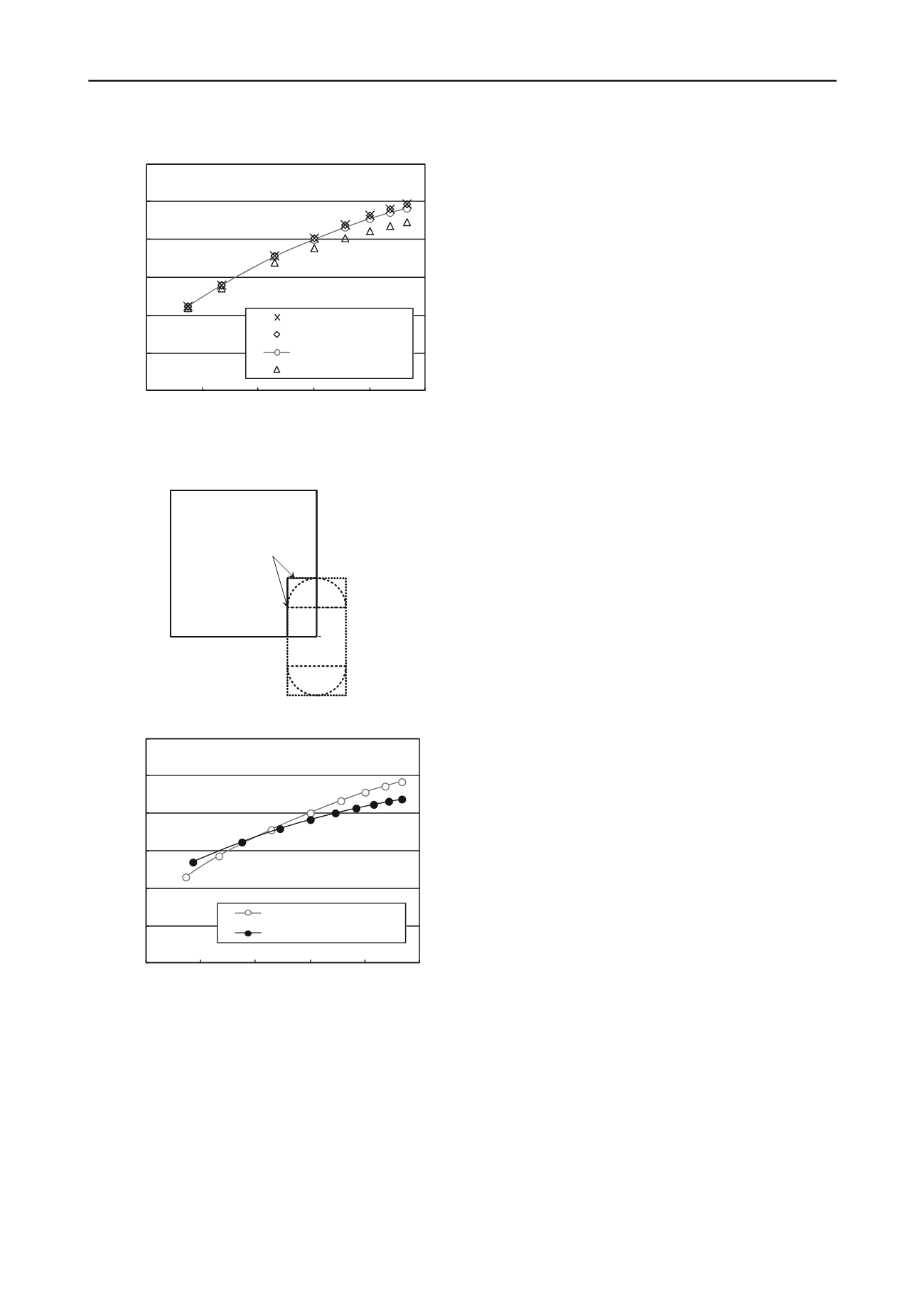
2106
Proceedings of the 18
th
International Conference on Soil Mechanics and Geotechnical Engineering, Paris 2013
0.0
0.2
0.4
0.6
0.8
1.0
1.2
0.2
0.3
0.4
0.5
0.6
0.7
H
c
w
/T
'
D/T
Calculated for 3D (1:4)
Calculated for 3D (1:3)
Calculated for 3D (1:2)
Calculated for 3D (1:1)
Figure 8. Relationships between
D/T
and
H
c
w
/T
’
for various plane
shapes
1
2
Sheet pile
Figure 9. Plane figure of the 3D test apparatus (axisymmetric modeling)
0.0
0.2
0.4
0.6
0.8
1.0
1.2
0.2
0.3
0.4
0.5
0.6
0.7
H
c
w
/T
'
D/T
Calculated for 3D flow (1:2)
Calculated for AXS flow
Figure 10. Relationship between
D/T
and
H
c
w
/T
’
(Axisymmetric
modeling of 3D flow)
means that assuming that the 3D flow is the same as AXS flow
leads to an overestimation of
H
c
, and generates unreasonable
results with respect to seepage failure.
(2)
D/T
> 0.40
H
c
values are smaller in the axisymmetric case
than in the three-dimensional case; the approximate accuracy,
(
H
c
AXS
H
c
3D
)
/H
c
3D
, is about
9% for
D/T
= 0.67. This means
that assuming that the 3D flow is the same as AXS flow leads to
an underestimation of
H
c
, and generates uneconomical designs
with respect to the
H
c
value.
For the same value of
D/T
, the
H
c
values are given as follows
in order of increasing magnitude:
B
:
L
= 1:1 < 1:2 < 1:3 < 1:4 as
applied in these four cases. So, the difference in
H
c
between 3D
and AXS flows changes, and the approximate accuracies, (
H
c
AXS
H
c
3D
)
/H
c
3D
, are given as
2% (1 :1),
9% (1 :2),
11%
(1 :3) and
12% (1:4) for
D/T
= 0.67.
stated in Section 4.3. The same axisymmetric approximation is
6 CONCLUSIONS
eriments were conducted under three-
een
orrelation with the above phenomenon regarding the
H
sides under the
led to the interesting conclusion
draulic head differences at deformation in the
for various
pla
lowest value in the case of 1:1.
of sheet piles,
e
H
c
values are nearly
ee-dimensional seepage
fai
em, axisymmetric
7 REFERENCES
Shortage of penetration depth of sheet piles,
Tan
Seepage failure exp
dimensional flow conditions for various cases of total depths of
soil,
T
, and penetrated depths of sheet piles,
D
, and analyses of
FEM seepage flow and stability against the seepage failure of
soil were carried out using the Prismatic failure concept 3D (pfc
3D). From discussions, the following results were obtained:
(1) With an increase in the hydraulic head difference betw
up- and downstream,
H
, the discharge at 15
C,
Q
15
, increases
linearly for a smaller value of
H
, but changes abruptly and non-
linearly beyond the point
H
H
d
.
H
d
is referred to as the
hydraulic head difference at an abrupt change of the
H-Q
15
curve.
(2) In c
and
Q
15
relationship, the height of the soil surface changes at
the front (downstream) and rear (upstream) of the sheet piles.
When
H
increases beyond
H
y
, a downstream rise and upstream
drop of the soil surface occur.
H
y
is referred to as the hydraulic
head difference at the onset of soil deformation.
(3) Sand particles move from up- to downstream
bottom edges of the sheet piles. The upstream soil surface is an
inverse conical shape centered at the outer corner of the
rectangular diaphragm wall.
(4) The experimental results
that
H
y
=
H
d
.
(5) The hy
experiment,
H
y
(=
H
d
), are nearly equal to the theoretical critical
hydraulic head differences based on the pfc 3D,
H
c
.
The theoretical critical hydraulic head differences
ne shapes of a cofferdam, e.g., a short to long length of 1:1,
1:2, 1:3, and 1:4, were calculated, and the following results
were obtained:
(6)
H
c
gives the
(7) For the same value of the penetration ratio
D/T
, the critical hydraulic head differences,
H
c
, are given as
follows in order of increasing magnitude: 1:1 < 1:2 < 1:3 < 1:4.
(8) For the same value of a short length, the more the longer
length increases, the smaller the effect of the longer length on
H
c
becomes.
H
c
in the case of 1:3 almost equals the
H
c
in the
case of 1:4 for the same value of
D/T
.
(9) For a small value of
D/T
, all of th
equal in cases of 1:1, 1:2, 1:3, and 1:4.
The axisymmetric modeling of thr
lure was discussed, concluding as follows:
(10) With respect to the seepage failure probl
seepage flow through soil within a cylindrical wall can be used
to model such a three-dimensional flow. The magnitudes of the
critical hydraulic head differences
H
c
3
D
(in three dimensions)
and
H
c
AXS
(axisymmetric model) are given as follows for the
3D case of 1:2 and its axisymmetric model:
H
c
3D
<
H
c
AXS
for
D/T
is
0.40, and
H
c
3D
>
H
c
AXS
for
D/T
> 0.40.
Nikkei Construction. 2001.
Nikkei Business Publications, 37-38, 2001.9.28.
Tanaka T., Naganuma H., Shinha M., Kusumi S. and Inoue K. 2011.
Anisotropic permeability of soil on 3D seepage failure experiments,
Procs. of the 68th annual meeting of the Kyoto Branch of Japanese
Society of Irrigation
, Drainage and Rural Engineering, 3-5 - 3-6.
aka T., Hirose D. and Kusumi S. 2012. Seepage failure of sand
within a cofferdam in three dimensions –Prismatic failure concept
3D and analytical consideration–,
Report of Research Center for
Urban Safety and Security
, Kobe University, No.12, 285-299.


